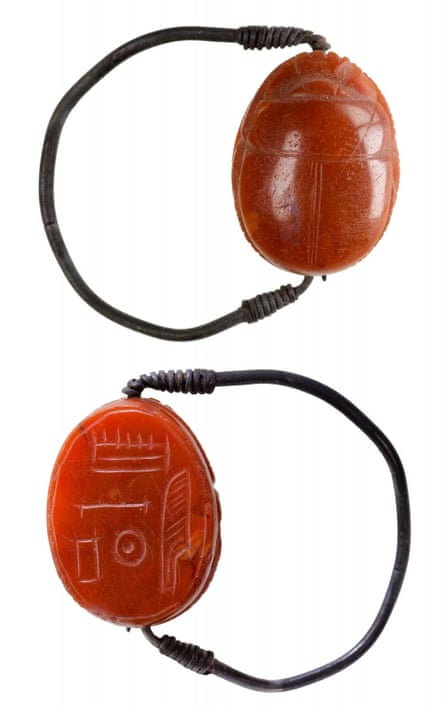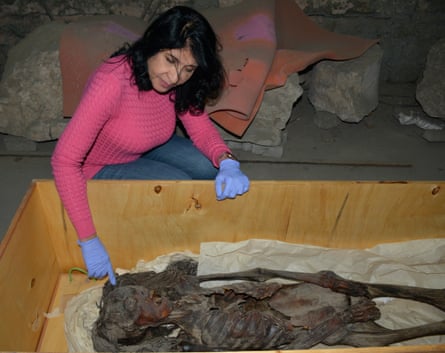She looks uncannily like The Scream painting by Edvard Munch, but just why an ancient Egyptian mummy has such a startling expression has long puzzled researchers. Now they say they may have the answer – suggesting the woman died crying out in agony.
The woman is thought to have been buried about 3,500 years ago and was discovered in 1935 in a wooden coffin beneath the tomb of Senmut – an important architect during the reign of the female pharaoh Hatshepsut.
She wasn’t alone: archaeologists also discovered a burial chamber for Senmut’s mother, Hat-Nufer, at the site near Luxor as well as individual burials of his relatives.
“Although no name was recorded on the screaming mummy, she was likely a close family member to be buried and share the family’s eternal resting place,” said Dr Sahar Saleem, professor of radiology at Cairo University.
Writing in the journal Frontiers in Medicine, Saleem and her co-author, Dr Samia El-Merghani, report how they used computerised tomography (CT) scanning technology to “virtually dissect” the mummy as well as techniques including X-ray-diffraction-analysis to investigate the skin, hair and long black wig.

The team say the mummy was well preserved, estimating the woman would have stood about 1.55 metres (just over 5ft) tall when alive. The CT scans offered further insights, revealing she died around 48 years old and had mild arthritis – including in her spine.
However the researchers found no sign of an embalming incision, and all the organs were still inside the mummy.
“This was a surprise to me, as the classic method of mummification in the New Kingdom – 1550-1069BC – included the removal of all organs except the heart,” said Saleem.
While study notes such an omission was often down to shoddy mummification of the middle and poorer classes, Saleem said that does not appear to have been the case for the screaming woman.
Not only was she buried wearing two scarab rings in silver and gold, but the researchers found the embalming materials included juniper resin and frankincense – expensive imported ingredients that may have aided the body’s preservation.
The analyses revealed juniper, as well as henna, on the woman’s hair, while the wig was made from braided date palm fibres and showed traces of juniper and frankincense as well as various minerals – possibly, Saleem suggests, to stiffen the fibres and give them a youthful black colour.
The researchers suggest the findings not only offer insights into mummification, wig making, and the ancient trade of embalming materials but indicate the woman’s open mouth was unlikely to be down to careless embalmers who neglected to close it.
Instead the team propose the woman’s expression may be down to a rare, immediate form of rigor mortis.
“We suggested that the reason [for] this opened mouth could be due to [a] painful death or emotional stress and cadaveric spasm made her face frozen to the appearance at time of death,” said Saleem. “Embalmers were unable to close the mouth and mummified the contracted body before it decomposed or relaxed, preserving her open mouth after death.”
However the cause of death remains unclear, while the researchers note other experts have proposed a screaming expression could be the result of burial procedures or changes after death.
Salima Ikram, distinguished university professor at the American University in Cairo, was not convinced by the team’s proposal.
“I don’t really think this spasm would have been something that the embalmer would have tried to retain for eternity. Thus I think [the expression] is [down to] something else,” she said, adding that the desiccation process during mummification takes 40 days. “Surely they could have rearranged her features [in that time],” Ikram said.
Dr Stuart Hamilton, a Home Office registered forensic pathologist, said there is debate over the very idea of cadaveric spasms, adding he has never seen a convincing case.

“I’m open-minded to the idea it exists, although it is certainly controversial,” he said. But he added a complicated explanation isn’t required: “I would think that the mouth has just fallen open and it’s ended up staying that way.”
While rare, the woman is not the only “screaming” mummy. Saleem and colleagues have previously studied the corpse of what is thought to be Prince Pentawere, the son of Pharaoh Ramesses III who was involved in a plot to kill his father.
“Pentawere’s body was barely embalmed, which may indicate that the embalmers neglected to keep his mouth closed likely as a punishment causing him to scream for eternity,” said Saleem.
The remains of Princess Meritamun, thought to be the sister of King Ahmose, who ruled from about 1550 to 1525BC, also has such an expression.
Saleem and colleagues say their previous work suggests Meritamun died of a sudden and massive heart attack. “The widely opened mouth was likely natural postmortem jaw drop that was maintained due to a postmortem muscle contraction – rigor mortis – that prevented embalmers from closing her mouth,” said Saleem.
Source: theguardian.com


















